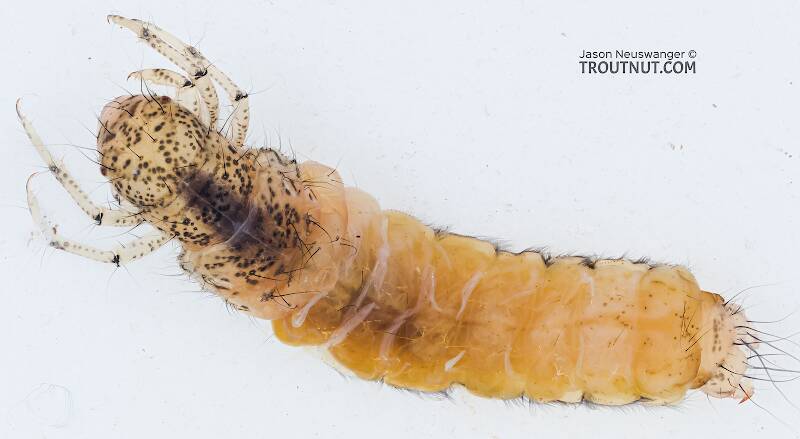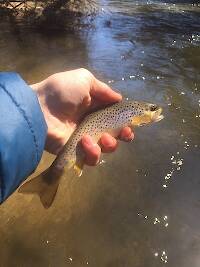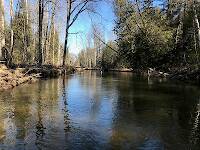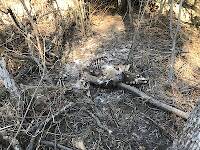
Salmonflies
Pteronarcys californica
The giant Salmonflies of the Western mountains are legendary for their proclivity to elicit consistent dry-fly action and ferocious strikes.
Featured on the forum

This is a striking caddis larva with an interesting color pattern on the head. Here are some characteristics I was able to see under the microscope, but could not easily expose for a picture:
- The prosternal horn is present.
- The mandible is clearly toothed, not formed into a uniform scraper blade.
- The seems to be only 2 major setae on the ventral edge of the hind femur.
- Chloride epithelia seem to be absent from the dorsal side of any abdominal segments.
Based on these characteristics and the ones more easily visible from the pictures, this seems to be Grammotaulius. The key's description of the case is spot-on: "Case cylindrical, made of longitudinally arranged sedge or similar leaves," as is the description of the markings on the head, "Dorsum of head light brownish yellow with numerous discrete, small, dark spots." The spot pattern on the head is a very good match to figure 19.312 of Merritt R.W., Cummins, K.W., and Berg, M.B. (2019). The species ID is based on Grammotaulius betteni being the only species of this genus known in Washington state.
- The prosternal horn is present.
- The mandible is clearly toothed, not formed into a uniform scraper blade.
- The seems to be only 2 major setae on the ventral edge of the hind femur.
- Chloride epithelia seem to be absent from the dorsal side of any abdominal segments.
Based on these characteristics and the ones more easily visible from the pictures, this seems to be Grammotaulius. The key's description of the case is spot-on: "Case cylindrical, made of longitudinally arranged sedge or similar leaves," as is the description of the markings on the head, "Dorsum of head light brownish yellow with numerous discrete, small, dark spots." The spot pattern on the head is a very good match to figure 19.312 of Merritt R.W., Cummins, K.W., and Berg, M.B. (2019). The species ID is based on Grammotaulius betteni being the only species of this genus known in Washington state.

Troutnut is a project started in 2003 by salmonid ecologist Jason "Troutnut" Neuswanger to help anglers and
fly tyers unabashedly embrace the entomological side of the sport. Learn more about Troutnut or
support the project for an enhanced experience here.
Entoman on Feb 16, 2012February 16th, 2012, 8:07 pm EST
I gathered that was your interest in the jigs. I looked a bit into hook sizes and could not find them less than a size 12.
I looked and looked and couldn't find any either. Too bad 'cause there's really a need! That is, if the fish agree with our theories!:)
I only use the yarn/right angle/mending type presentation on slow, or smooth, flows. When it comes to more turbulent water, I allow the flies to be lead, making sure the faster surface currents are flowing past (moving faster than) the indicator.
Ah, I think I understand what you're doing now...
Less anyone be misled, the methods presented and discussed here are complimentary, not contradictory, and they all have their place.
Absolutely!
"It's not that I find fishing so important, it's just that I find all other endeavors of Man equally unimportant... And not nearly as much fun!" Robert Traver, Anatomy of a Fisherman
Feathers5
Posts: 287
Posts: 287
Feathers5 on Feb 17, 2012February 17th, 2012, 4:27 am EST
I've been thinking, do you really believe a nymph that has been dislodged from a rock or whatever, only floats right side up? I think it would be tumbling in the current. Just a thought.
Bruce
Bruce
Oldredbarn on Feb 17, 2012February 17th, 2012, 5:45 am EST
I've been thinking, do you really believe a nymph that has been dislodged from a rock or whatever, only floats right side up? I think it would be tumbling in the current. Just a thought.
Bruce
Bruce,
I think you might be surprised...The one's that are adept at swiming have little problem getting re-oriented and getting back to solid ground...
Last fall I spent an eveing with an angling friend fishing the Manistee just a bit south-west of Grayling. He's a retired biology teacher so part of the evening was spent like two 10 year old boys playing hooky and we were trying to find bugs. We found a nice silt bed and dug up a couple Hex...My friend put them in my hand and the "wigglers" were surprisingly strong flopping around in my hand...Once I placed them back in the water they high-tailed it back to the bottom and disappeared back into the silt in mere moments.
Clingers may have a harder time I might think, but this is their world and they are built for it. It may be a bit hard for me to explain but the nymph does this inverted thing, the opposite of a curved scud hook, where they stiffen out, like a u-shape, head up and tail up, legs out and drift back down...Like a glider maybe???
Spence
"Even when my best efforts fail it's a satisfying challenge, and that, after all, is the essence of fly fishing." -Chauncy Lively
"Envy not the man who lives beside the river, but the man the river flows through." Joseph T Heywood
"Envy not the man who lives beside the river, but the man the river flows through." Joseph T Heywood
Martinlf on Feb 17, 2012February 17th, 2012, 6:35 am EST
Yes, Spence, and an upside down nymph tied on a scud hook mimics this posture.
"He spread them a yard and a half. 'And every one that got away is this big.'"
--Fred Chappell
--Fred Chappell
PaulRoberts on Feb 17, 2012February 17th, 2012, 7:33 am EST
Kurt,
Jig heads: Although the regular big manufacturers only offer jig hooks down to #12, I have some as small as #14 hooks. So some overseas, likely Asian possibly European, manufacturer is making them. Here are a couple US links with #14 and #12 jig heads ready to purchase. There are undoubtedly others.
https://www.troutmagnet.com/store/mini-magnet-jig-heads-5-pc-pack-p-384.html
http://www.jannsnetcraft.com/jig-heads-unpainted/315418.aspx
Bruce,
Here's my take:
-Current varies, so insects can be tossed all about in places. In other places they can right themselves. It depends too on why they are in "the drift”. Are they redistributing by “planned” behavioral drift, or dislodged in "catastrophic drift”.
-Insects vary tremendously in swimming ability. Those that can swim are more apt to be exposed to current, and have adaptations to living “on the edge”. I’ve mentioned before how well golden stoneflies (active predators) can swim! If dislodged, or even dropped on the surface as I’ve done it, they do not stay in the current for long. Try it. Pteronarcys stoneflies are a different animal. They live well under boulders in the detrital zone and if dropped into current they roll up and tumble, relying it appears on sheer weight and their “roundness” to get them back into a crevice somewhere. (Hey did you know Dobson larvae can swim? It’s…fittingly disgusting how they do it too. Nothing short of a jig can mimic it well either). Further, inanimate objects are much more random in behavior than most living critters (except maybe Pteronarcys lol). These abilities change as the insects develop through their life cycle too. So… the question is not a simple one.
I have fly patterns that I care much less about how they are oriented, and they seem to catch fish just fine. These I believe are due to the water type/conditions in which they are fished, and/or the critters I’m trying to mimic.
But I’ve had others in which it appears to matter –Baetis nymphs for one, various emergers, dry flies certainly at times. I feel I know this bc I’ve had refusals to flies that don’t look right, switched and started catching again. Also, I’m a strong believer in fly action being a strong trigger. I’m actually a multi-species, multi-tackle angle-aholic (I get as heavy into other types of fishing as I do fly fishing) and I can tell you that action is HUGE. This is much harder to accomplish with flies though bc they are so small and water is so thick. When I said in the Gammarus thread that this area is the next level, the holy grail, of fly-tying, this is where the thought came from. We can’t do too much more visually (in hand) to our flies I think. But action, how the fly behaves in the water, is whole ‘nother door.
So…why do silly-looking flies catch trout?:
Trout, when not hyper-focused on a particular food item, feed eclectically. They do not have hands and sample things in the drift by eye/snout/jaw/mouth. I’ve seen this in my own RiverTank at home, as well as on the stream. (I believe Jason’s present research is along this line; Will be interesting what he finds). Eclectically sampling trout might try almost anything once.
I’ll share a story, one of many that pertain to the topic, but one in which I had an audience and the responses of the anglers were interesting, and telling:
It was early spring and the water was slightly off-colored and cold on a locally popular stream. No one was catching and before too long most fishers had had their energy drained. Trout were gathered in slower pockets, eddies, and pool basins. I’d hit each pocket, catch a trout or two, and then…nothing. Instead of moving on, I’d switch flies, and catch one or two more. Then, nothing… So I’d switch again. … and catch again. What was happening, (and often happens), is that nearly all the trout in those pockets and pool basins were sampling my flies, until they discovered that they were “not food”. Then they just filtered that particular image out. So...I’d give them a new image and they’d try it. … (Realize we do not detect all, if even many, of the “sampling” our flies receive from trout.)
Anglers that saw me catching, stopped to watch and then ask… of course …”What are they taking?” “Well…just about everything today.” I’d respond. “Oh, a presentationist.” I heard one guy mumble. Yes…that’s where we must to start. Can’t go anywhere without it. But once you have presentation down, the image trout see looms large. And every food item provides a potentially different, potentially recognizable, image.
Now let’s switch to some “selective” (or maybe better “focused on a particular image”) scenarios: An early spring game I loved was the Hendrickson emergence. I couldn’t wait to cast to those early afternoon risers. But the daily game started much earlier. E. subvaria nymphs were crowding up onto their mid-riffle launchpad cobbles, getting ready to go. Some couldn’t wait, or got jostled or chased off, and swept into the pools. Good trout held in the head riffs and I can tell you those dark little bodies rolling and fluttering in, were marked! Since these nymphs were often tumbling, but capable of laborious swimming, a simple in the round tie did the job. My catch rates more than doubled by my offering a nearly black #12 nymph tied roughly in the round with a turkey plume tail. And what a difference that made compared to “just any old pattern”. Trout could recognize that image from a distance and their exuberance made the catching easy!
Now contrast this with the spring Baetis emergences I enjoy (not love, as it’s just not the same as those big Hennies). The Baetis spill out of the same riffles, and likely they spin a bit, and appear to travel a ways, before swimming to the top to pop. But such a tiny nymph is both tougher for fish to see, and the imitation tougher to fish, esp in turbulent or higher slightly off-colored spring flows. It's more..."technical" fishing. And the gangbusters thing doesn’t happen quite the same as with those big black subvaria. My best opportunities with the Baetis has been somewhat further down the pool, where the water is smoother. The ends of the current tongues, seams, and tailouts, are the top places.
These areas seem to require a nymph that is properly oriented though –at least I believe this bc I’ve had repeated refusals to damaged nymphs that run funny, and start re-catching after tying on a fresh fly. This seems similar to having the right dry fly design but we just can’t see the nymphs as well, or we don’t bother to look and just trust the fly is looking enticing. With such a small nymph, the tippet is more apt to affect how the fly looks and behaves, something we get all anal over with dries.
Might it be that that particular trout is just responding “eclectically”, to a new “might be food”? This could play a role in what trout might consider a passable Baetis mimic, but I’ve had certain cock-eyed nymphs fail on several fish, only to switch to a properly oriented fly, and had it be magic, that lasts until the magic gets “beaten out of it”.
On some hard fished waters, cripple dries outfish the perky ones, and this may be a response to fishing pressure. Is this, as Lloyd would have it, fish are simply responding negatively to proper flies, and less so to improper ones? Could well be in places and times. But I think I've seen some ability for discernment in trout too and do want some control over my flies.
Trout are good at discerning “food’ from “not food”. And there are plenty of designs that just plain fail. It behooves us to give them something they recognize as “food” (what that looks like varies, as above), or if not, offer them something that “might be food”. You can catch a lot of fish, at times, practicing the latter. But you’ll catch many more, at times, with the former. Where, or even if, fly orientation (and action) fits in I think depends on the water, the trout, and the particular insect or its life stage. Not all the above “factors” are isolated answers by themselves, but ones at play in varying amounts.
This is as I presently understand things –the house of cards I’ve built to explain what I think I’ve seen.
Jig heads: Although the regular big manufacturers only offer jig hooks down to #12, I have some as small as #14 hooks. So some overseas, likely Asian possibly European, manufacturer is making them. Here are a couple US links with #14 and #12 jig heads ready to purchase. There are undoubtedly others.
https://www.troutmagnet.com/store/mini-magnet-jig-heads-5-pc-pack-p-384.html
http://www.jannsnetcraft.com/jig-heads-unpainted/315418.aspx
I've been thinking, do you really believe a nymph that has been dislodged from a rock or whatever, only floats right side up? I think it would be tumbling in the current. Just a thought.
Bruce
Bruce,
Here's my take:
-Current varies, so insects can be tossed all about in places. In other places they can right themselves. It depends too on why they are in "the drift”. Are they redistributing by “planned” behavioral drift, or dislodged in "catastrophic drift”.
-Insects vary tremendously in swimming ability. Those that can swim are more apt to be exposed to current, and have adaptations to living “on the edge”. I’ve mentioned before how well golden stoneflies (active predators) can swim! If dislodged, or even dropped on the surface as I’ve done it, they do not stay in the current for long. Try it. Pteronarcys stoneflies are a different animal. They live well under boulders in the detrital zone and if dropped into current they roll up and tumble, relying it appears on sheer weight and their “roundness” to get them back into a crevice somewhere. (Hey did you know Dobson larvae can swim? It’s…fittingly disgusting how they do it too. Nothing short of a jig can mimic it well either). Further, inanimate objects are much more random in behavior than most living critters (except maybe Pteronarcys lol). These abilities change as the insects develop through their life cycle too. So… the question is not a simple one.
I have fly patterns that I care much less about how they are oriented, and they seem to catch fish just fine. These I believe are due to the water type/conditions in which they are fished, and/or the critters I’m trying to mimic.
But I’ve had others in which it appears to matter –Baetis nymphs for one, various emergers, dry flies certainly at times. I feel I know this bc I’ve had refusals to flies that don’t look right, switched and started catching again. Also, I’m a strong believer in fly action being a strong trigger. I’m actually a multi-species, multi-tackle angle-aholic (I get as heavy into other types of fishing as I do fly fishing) and I can tell you that action is HUGE. This is much harder to accomplish with flies though bc they are so small and water is so thick. When I said in the Gammarus thread that this area is the next level, the holy grail, of fly-tying, this is where the thought came from. We can’t do too much more visually (in hand) to our flies I think. But action, how the fly behaves in the water, is whole ‘nother door.
So…why do silly-looking flies catch trout?:
Trout, when not hyper-focused on a particular food item, feed eclectically. They do not have hands and sample things in the drift by eye/snout/jaw/mouth. I’ve seen this in my own RiverTank at home, as well as on the stream. (I believe Jason’s present research is along this line; Will be interesting what he finds). Eclectically sampling trout might try almost anything once.
I’ll share a story, one of many that pertain to the topic, but one in which I had an audience and the responses of the anglers were interesting, and telling:
It was early spring and the water was slightly off-colored and cold on a locally popular stream. No one was catching and before too long most fishers had had their energy drained. Trout were gathered in slower pockets, eddies, and pool basins. I’d hit each pocket, catch a trout or two, and then…nothing. Instead of moving on, I’d switch flies, and catch one or two more. Then, nothing… So I’d switch again. … and catch again. What was happening, (and often happens), is that nearly all the trout in those pockets and pool basins were sampling my flies, until they discovered that they were “not food”. Then they just filtered that particular image out. So...I’d give them a new image and they’d try it. … (Realize we do not detect all, if even many, of the “sampling” our flies receive from trout.)
Anglers that saw me catching, stopped to watch and then ask… of course …”What are they taking?” “Well…just about everything today.” I’d respond. “Oh, a presentationist.” I heard one guy mumble. Yes…that’s where we must to start. Can’t go anywhere without it. But once you have presentation down, the image trout see looms large. And every food item provides a potentially different, potentially recognizable, image.
Now let’s switch to some “selective” (or maybe better “focused on a particular image”) scenarios: An early spring game I loved was the Hendrickson emergence. I couldn’t wait to cast to those early afternoon risers. But the daily game started much earlier. E. subvaria nymphs were crowding up onto their mid-riffle launchpad cobbles, getting ready to go. Some couldn’t wait, or got jostled or chased off, and swept into the pools. Good trout held in the head riffs and I can tell you those dark little bodies rolling and fluttering in, were marked! Since these nymphs were often tumbling, but capable of laborious swimming, a simple in the round tie did the job. My catch rates more than doubled by my offering a nearly black #12 nymph tied roughly in the round with a turkey plume tail. And what a difference that made compared to “just any old pattern”. Trout could recognize that image from a distance and their exuberance made the catching easy!
Now contrast this with the spring Baetis emergences I enjoy (not love, as it’s just not the same as those big Hennies). The Baetis spill out of the same riffles, and likely they spin a bit, and appear to travel a ways, before swimming to the top to pop. But such a tiny nymph is both tougher for fish to see, and the imitation tougher to fish, esp in turbulent or higher slightly off-colored spring flows. It's more..."technical" fishing. And the gangbusters thing doesn’t happen quite the same as with those big black subvaria. My best opportunities with the Baetis has been somewhat further down the pool, where the water is smoother. The ends of the current tongues, seams, and tailouts, are the top places.
These areas seem to require a nymph that is properly oriented though –at least I believe this bc I’ve had repeated refusals to damaged nymphs that run funny, and start re-catching after tying on a fresh fly. This seems similar to having the right dry fly design but we just can’t see the nymphs as well, or we don’t bother to look and just trust the fly is looking enticing. With such a small nymph, the tippet is more apt to affect how the fly looks and behaves, something we get all anal over with dries.
Might it be that that particular trout is just responding “eclectically”, to a new “might be food”? This could play a role in what trout might consider a passable Baetis mimic, but I’ve had certain cock-eyed nymphs fail on several fish, only to switch to a properly oriented fly, and had it be magic, that lasts until the magic gets “beaten out of it”.
On some hard fished waters, cripple dries outfish the perky ones, and this may be a response to fishing pressure. Is this, as Lloyd would have it, fish are simply responding negatively to proper flies, and less so to improper ones? Could well be in places and times. But I think I've seen some ability for discernment in trout too and do want some control over my flies.
Trout are good at discerning “food’ from “not food”. And there are plenty of designs that just plain fail. It behooves us to give them something they recognize as “food” (what that looks like varies, as above), or if not, offer them something that “might be food”. You can catch a lot of fish, at times, practicing the latter. But you’ll catch many more, at times, with the former. Where, or even if, fly orientation (and action) fits in I think depends on the water, the trout, and the particular insect or its life stage. Not all the above “factors” are isolated answers by themselves, but ones at play in varying amounts.
This is as I presently understand things –the house of cards I’ve built to explain what I think I’ve seen.
Feathers5
Posts: 287
Posts: 287
Feathers5 on Feb 17, 2012February 17th, 2012, 8:27 am EST
Okay, Paul. I'm seeing your points and they make sense. Here's what I'm planning to do when the Spring season appears. I'm going to fish a particular run and if I catch a few fish, and then get no more responses, I'm going to changes flies to see if that does the trick. This is, of course, to see if they are just sampling for food. I'll let you now how I make out.
Bruce
Bruce
Entoman on Feb 17, 2012February 17th, 2012, 8:29 am EST
Thanks for the links, Paul!
"It's not that I find fishing so important, it's just that I find all other endeavors of Man equally unimportant... And not nearly as much fun!" Robert Traver, Anatomy of a Fisherman
PaulRoberts on Feb 17, 2012February 17th, 2012, 10:09 am EST
Okay, Paul. I'm seeing your points and they make sense. Here's what I'm planning to do when the Spring season appears. I'm going to fish a particular run and if I catch a few fish, and then get no more responses, I'm going to changes flies to see if that does the trick. This is, of course, to see if they are just sampling for food. I'll let you now how I make out.
Bruce
Unless conditions are extreme, they ARE sampling for "food". Whether they have a specific image they are onto is something to keep tabs on. On the Delaware they are more apt to be hyper-focused, and possibly more prone to respites. On less productive waters, trout are more apt to be feeding eclectically, nearly all the time. Insert angler.
Martinlf on Feb 17, 2012February 17th, 2012, 2:20 pm EST
Thank you, Paul. Lots to think about in your post.
"He spread them a yard and a half. 'And every one that got away is this big.'"
--Fred Chappell
--Fred Chappell
Quick Reply
Related Discussions
Topic
Replies
Last Reply
0
Jul 2, 2012
by Bjorntofish
by Bjorntofish










